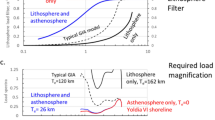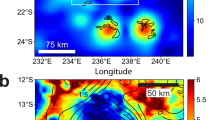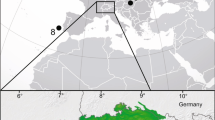Abstract
THE aseismicity of the Moon has been interpreted1 as an indication that the Moon is relatively cold in the interior. More precisely, the temperature T (z) at depth z is inferred to be so low that the strength σmax (T, τ) of the rock over the appropriate time scale τ is greater than the ambient shear stress σ (z, τ), so that no displacement occurs. (The time scales range from weeks for tidal stresses to aeons for mascon stresses.) Unfortunately, we have only a poor understanding of the long term strength σmax and of the fields of stress. Hence this argument can put only rough upper limits on the temperature profile; it is definitely below the solidus, and probably considerably below it.
This is a preview of subscription content, access via your institution
Access options
Subscribe to this journal
Receive 51 print issues and online access
$199.00 per year
only $3.90 per issue
Buy this article
- Purchase on Springer Link
- Instant access to full article PDF
Prices may be subject to local taxes which are calculated during checkout
Similar content being viewed by others
References
Latham, G., Ewing, M., Press, F., Sutton, G., Dorman, J., Nakamura, Y., Toksöz, N., Wiggins, R., Derr, J., and Dunnebier, F., Science, 167, 455 (1970).
Brace, W. F., and Byerlee, J. D., Science, 153, 990 (1966).
Brace, W. F., and Byerlee, J. D., Science, 168, 1573 (1970).
Brace, W. F., Tectonophysics (in the press).
Clark, S. P., and Ringwood, A. E., Rev. Geophys., 2, 35 (1964).
Langseth, M. E., Clark, S. P., and Wechsler, A. E., The Apollo 15 Lunar Heat Flow Measurement in Lunar Sci. Inst. Conf. on Lunar Geophys., Houston (1971).
Toksöz, M. N., Solomon, S. C., Minear, J. W., and Johnston, D. H., The Moon (in the press).
Latham, G., Ewing, M., Dorman, J., Lammlein, D., Press, F., Toksöz, N., Sutton, G., Dunnebier, F., and Nakamura, Y., Science, 174, 687 (1971).
Conel, J. E., and Holstrom, G. B., Science, 162, 1403 (1968).
O'Keefe, J. A., Science, 162, 1405 (1968).
Ringwood, A. E., and Essene, E., Geochim. Cosmochim. Acta Suppl., 1, 769 (1970).
Author information
Authors and Affiliations
Rights and permissions
About this article
Cite this article
THOMSEN, L. Implications of Lunar Aseismicity. Nature 240, 94–95 (1972). https://doi.org/10.1038/240094a0
Received:
Revised:
Issue Date:
DOI: https://doi.org/10.1038/240094a0
This article is cited by
-
The relationship between resistance to tobacco brown spot and nitrogen metabolism in mature tobacco (Nicotiana tabacum) plants
Tropical Plant Pathology (2015)
Comments
By submitting a comment you agree to abide by our Terms and Community Guidelines. If you find something abusive or that does not comply with our terms or guidelines please flag it as inappropriate.



